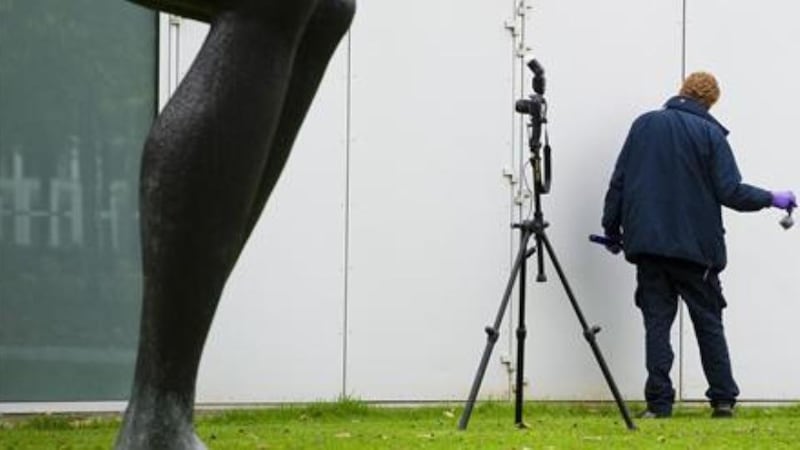A woman in Romania is suspected of burning several multi-million euro paintings - including a Matisse, a Picasso and a Monet - after museum officials said ash found in her oven contains paint, canvas and nails.
The finding is evidence that Olga Dogaru might have been telling the truth when she claimed to have burned the paintings, which were taken from a Dutch museum last year in a daring daylight heist.
Ernest Oberlander-Tarnoveanu, director of Romania’s National History Museum, said museum forensic specialists found “small fragments of painting primer, the remains of canvas, the remains of paint” and copper and steel nails, some of which pre-dated the 20th century.

“We discovered a series of substances which are specific to paintings and pictures,” he said, including lead, zinc and azurite.
He refused to say definitively that the ashes were those of the seven paintings stolen from Rotterdam’s Kunsthal gallery last year, because he said it was not his position to do so. He said justice officials would make that decision.
He did venture that if the remains were those of the paintings, it was “a crime against humanity" to destroy the artworks. “I can’t believe in 2013 that we come across such acts,” he said.
Mr Oberlander-Tarnoveanu said forensic specialists at the museum have been analysing ashes from Ms Dogaru’s stove since March and will hand their results to prosecutors next week.
Ms Dogaru's son is charged with stealing the seven paintings, which were stolen in October in the biggest art heist to hit the Netherlands for more than a decade. Thieves broke in through a rear emergency exit of the gallery, grabbed the paintings off the wall and fled, all within two minutes.
The stolen works have an estimated value of €100 million if sold at auction. Thieves took Pablo Picasso’s 1971 Harlequin Head; Claude Monet’s 1901 Waterloo Bridge, London, and Charing Cross Bridge, London; Henri Matisse’s 1919 Reading Girl in White and Yellow; Paul Gauguin’s 1898 Girl in Front of Open Window; Meyer de Haan’s Self-Portrait of around 1890; and Lucian Freud’s 2002 work Woman with Eyes Closed.
Three Romanian suspects were arrested in January, but the paintings have not been found.
Romanian prosecutors say Ms Dogaru - whose son Radu is the alleged heist ringleader - claims she buried the art in an abandoned house and then in a cemetery in the village of Caracliu. She said she later dug the paintings up and burned them in February after police began searching the village for the stolen works.
Prosecutors have not said whether they believe her account, but Pavel Susara, a Romanian art critic, said the story has the ring of truth. "Olga Dogaru describes how she made the fire, put wood on it and burned the paintings, like she was burning a pair of slippers," he said. "She's either a repressed writer or she is describing exactly what she did."
Now the museum staff have found exactly what forensic experts say they were seeking - materials such as canvas, wood, staples, and paints that indicate the ashes were the remains of artworks.
The next step would be to compare them to what is known about the missing paintings, which given their quality and status would be well-documented in photographs and condition reports.
"If one finds general similarities between the stolen works and the burned (remains), then one could test the elemental - and possibly chemical - composition of the burned works to determine if they could be consistent with the stolen works," said James Martin of Orion Analytical, who has taught forensic paint analysis at the FBI Academy Counter-terrorism and Forensic Science Research Unit.
Art market experts said the Rotterdam thieves might have discovered what many art thieves have before them - that easily identifiable paintings by famous artists are extremely difficult to sell at anything like their auction value.
"Criminals who are successful in their usual endeavours are often undone by a foray into art theft," said Robert Korzinek, a fine art underwriter at insurer Hiscox. "They steal these works of art ... and then they have the problem that they can't dispose of them."
That means many works suffer ignominious fates. Some are lost forever, while others turn up after years of being buried or stashed in storage. Edvard Munch’s The Scream, stolen from an Oslo museum in 2004, was recovered in 2006, water damaged and torn. Police have never offered details on the painting’s whereabouts during those two years.
Chris Marinello of the Art Loss Register, which specialises in tracking down stolen artworks, said that if Ms Dogaru is telling the truth, "this isn't the first time the mothers of art thieves have come to the rescue of their son".
One famous case involved a prolific French criminal named Stephane Breitwieser, who stole more than 200 works from small museums across Europe in the late 1990s. His mother admitted destroying dozens of the works after police began investigating her son, cutting up paintings, stuffing the remnants down her garbage disposal and throwing valuable jewels and other antiquities into a canal. She was arrested after some of them resurfaced.
"Old Masters were washing up on the bank," Mr Marinello said.
More than 100 works were recovered from the mud and restored, but much of what Breitwieser stole was lost forever.
Mariette Maaskant, spokeswoman for Rotterdam's Kunsthal, said Ms Dogaru's allegation underscores the "pointlessness" of the theft. "If this terrible news is true, then the last trace of hope that the artworks would return is definitively gone," she said. "It would be a loss that touches every art lover."
PA








